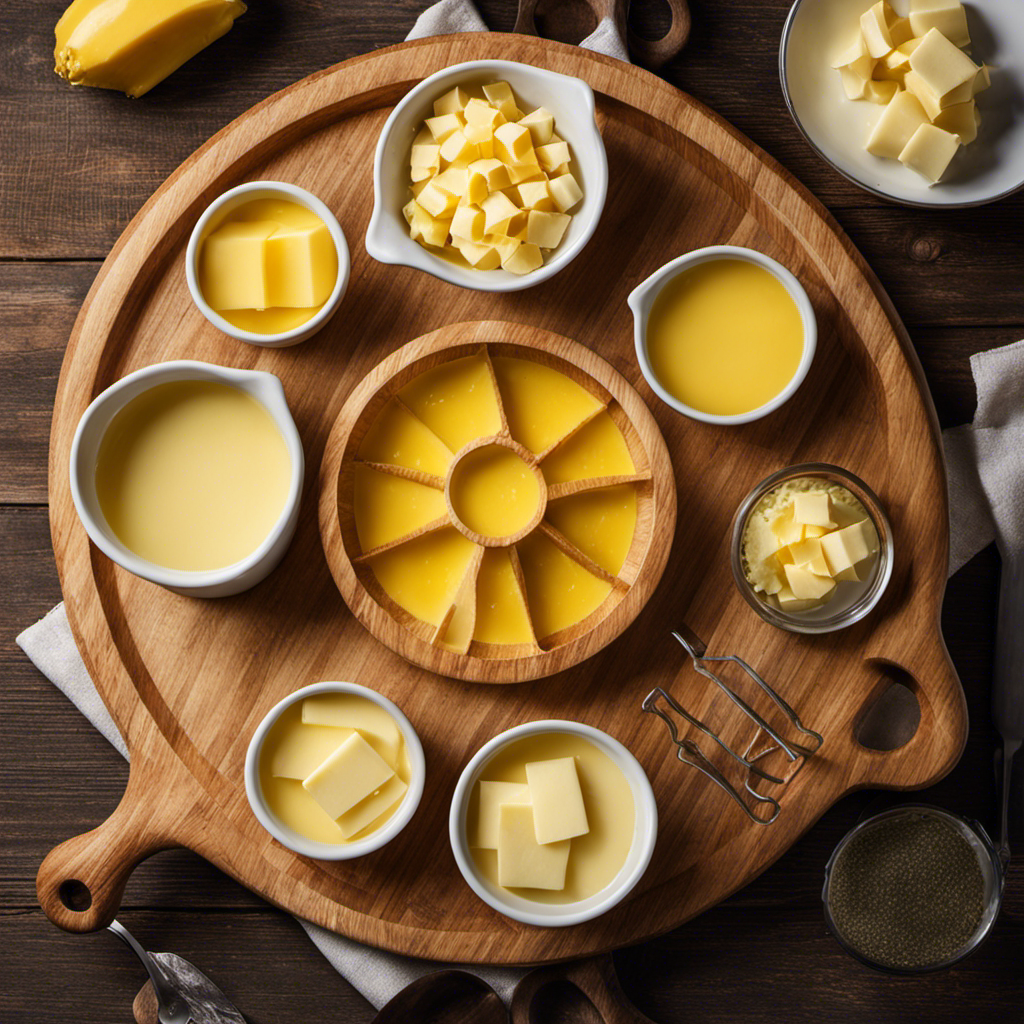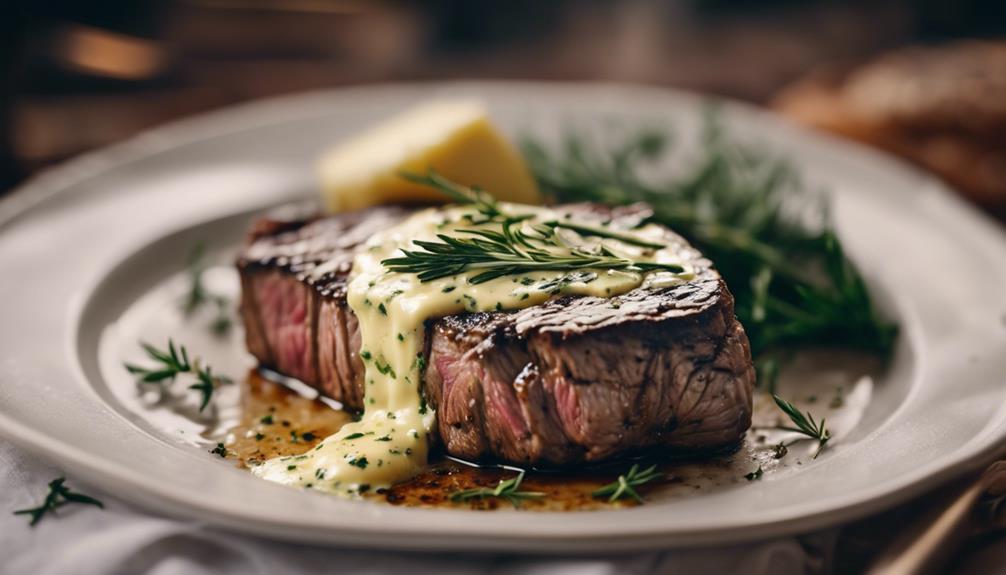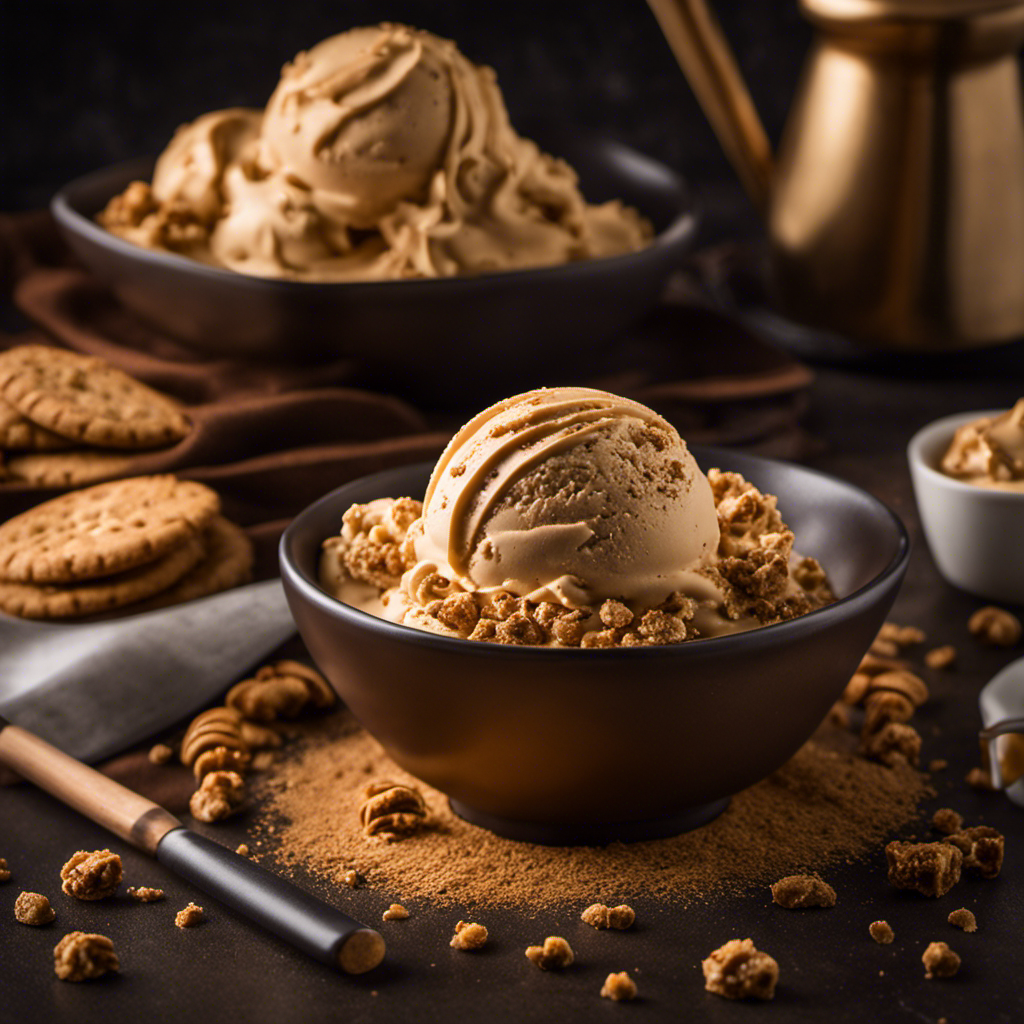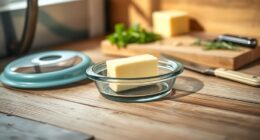Can you help me with a cooking question: how many tablespoons are in 3/4 stick of butter?
If you’re like me, you want to get your measurements just right. Well, I’ve done the math for you and I’m here to share the answer.
Stick around and I’ll break it down for you, step by step, so you’ll never have to guess again.
Get ready to become a butter-measuring pro!
Key Takeaways
- A 3/4 stick of butter is equivalent to 6 tablespoons.
- To convert a fraction of a stick, like 3/4, into tablespoons, multiply the number of sticks by 8.
- There are a total of 12 tablespoons in three-fourths of a stick of butter.
- Converting sticks to tablespoons helps in accurate butter measurement.
Understanding the Measurement: 3/4 Stick of Butter
I know that a 3/4 stick of butter is equivalent to 6 tablespoons. Understanding butter measurements is essential when it comes to following recipes accurately.
Butter is commonly sold in sticks, with each stick typically measuring 1/2 cup or 8 tablespoons. However, sometimes a recipe calls for a specific fraction of a stick, like 3/4. To convert this measurement into tablespoons, you simply multiply the number of sticks by 8. In this case, 3/4 of a stick is equal to 6 tablespoons.
It’s important to have a good grasp of converting butter measurements to ensure that your recipe turns out just right. Now that we understand the measurement of 3/4 stick of butter, let’s explore how to convert sticks to tablespoons for other measurements.
Converting Sticks to Tablespoons
There are a total of 12 tablespoons in three-fourths of a stick of butter.
When it comes to measuring butter, it’s important to understand the conversions between sticks and tablespoons. Butter is often sold in sticks, and each stick typically contains 8 tablespoons.
So, to determine the number of tablespoons in three-fourths of a stick, you can multiply 8 by 0.75 (which is the decimal equivalent of three-fourths). This calculation yields 6 tablespoons.
Therefore, if you’ve three-fourths of a stick of butter, you’ve 6 tablespoons. This conversion is useful when following recipes that require precise measurements.
Now that we know how to convert sticks to tablespoons, let’s move on to calculating the number of tablespoons in 3/4 stick of butter.
Calculating the Number of Tablespoons in 3/4 Stick of Butter
To calculate the number of tablespoons in three-fourths of a stick of butter, I simply multiply 8 by 0.75. This gives me a result of 6 tablespoons. However, it’s important to note that the equivalency of butter measurements can vary in different countries. In the United States, a stick of butter typically weighs 113 grams or 1/2 cup, which is equivalent to 8 tablespoons. However, in countries like Australia and New Zealand, a stick of butter is typically 250 grams, which is equivalent to 20 tablespoons. To ensure precise measurements, it’s useful to convert tablespoons to grams. For example, 1 tablespoon of butter is equal to approximately 14 grams. By converting tablespoons to grams, you can accurately measure the desired amount of butter for your recipe.
| Tablespoons | Grams |
|---|---|
| 1 | 14 |
| 2 | 28 |
| 3 | 42 |
| 4 | 56 |
| 5 | 70 |
Tips for Measuring Butter Accurately
One helpful tip for accurately measuring butter is using a kitchen scale to weigh the desired amount. This method ensures precision and eliminates any guesswork. However, if you don’t have a kitchen scale, there are alternative ways to measure butter accurately. Here are some tips to help you measure butter without a scale:
-
Use the measurement markings on the butter wrapper: Many butter sticks come with measurement markings on the wrapper, indicating tablespoons or ounces. Simply cut off the desired amount according to these markings.
-
Convert from weight to volume: If a recipe calls for a specific weight of butter, you can convert it to volume measurements. For example, one stick of butter is equivalent to 8 tablespoons or 1/2 cup.
-
Use a butter dish with markings: Some butter dishes have markings that indicate tablespoon measurements. This can be a convenient option for quick and easy butter measurement.
Common mistakes in butter measurement include using the wrong conversion ratios or not clarifying whether the butter should be melted or softened. It’s important to carefully read the recipe instructions and measure the butter accurately to achieve the desired results in your baking or cooking endeavors.
Converting Tablespoons to Other Units of Measurement
I find it helpful to convert tablespoons to other units of measurement when I need to accurately measure ingredients for a recipe. Converting tablespoons to grams is especially useful when dealing with ingredients like flour or sugar, where precision is key. Similarly, converting sticks to cups is important when working with butter or margarine. Here’s a table that shows the conversion rates for tablespoons to grams and sticks to cups:
| Measurement | Tablespoons to Grams | Sticks to Cups |
|---|---|---|
| 1 tablespoon | 14.3 grams | 1/8 cup |
| 2 tablespoons | 28.6 grams | 1/4 cup |
| 3 tablespoons | 42.9 grams | 3/8 cup |
Knowing these conversions can make it easier to follow recipes accurately and achieve consistent results. So the next time you come across a recipe that calls for tablespoons or sticks, you can confidently convert them to the units that work best for you.
Frequently Asked Questions
Can I Use Margarine Instead of Butter in This Recipe?
Sure, you can use margarine instead of butter in this recipe. Margarine is a suitable substitute, but keep in mind that it may alter the taste and texture. Consider the pros and cons before making the switch.
How Many Ounces Are in a Stick of Butter?
There are 16 tablespoons in a pound of butter. To convert sticks of butter to cups, the general rule is that 1 stick is equal to 1/2 cup. So, 3/4 stick of butter is approximately 3/8 cup.
How Much Butter Should I Use if the Recipe Calls for 2 Cups?
If a recipe calls for 2 cups of butter, you’ll need 4 sticks. To convert butter measurements, remember that 1 stick is equal to 8 tablespoons. Using butter in recipes adds richness and flavor.
Can I Use a Butter Substitute Like Coconut Oil or Olive Oil Instead?
Using coconut oil in baking can provide a unique flavor and texture to your dishes. However, if substituting for butter, keep in mind that coconut oil has a lower melting point. Olive oil, on the other hand, offers health benefits and can be a suitable alternative in some recipes.
What Is the Difference Between Salted and Unsalted Butter?
The difference between salted and unsalted butter lies in the presence or absence of salt. Salted butter contains added salt for flavor, while unsalted butter is pure butter without any added salt. Salted butter can be used in both sweet and savory recipes, while unsalted butter is more versatile in baking. Clarified butter is butter that has had its milk solids removed, resulting in a higher smoke point and longer shelf life. Cultured butter is made from cream that has been fermented, giving it a tangy flavor. Butter is generally considered healthier than margarine, as it is a natural product without any artificial ingredients or trans fats.
Conclusion
In the culinary world, understanding measurements is key to creating delicious dishes.
When it comes to butter, converting sticks to tablespoons allows for accurate measurements.
By calculating the number of tablespoons in 3/4 stick of butter, you can ensure your recipes turn out just right.
Remember to measure butter accurately to achieve the desired taste and texture.
And if you ever need to convert tablespoons to other units of measurement, you now have the knowledge to do so with confidence.
Happy cooking!










